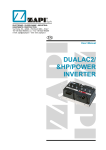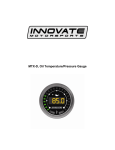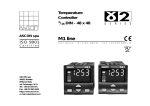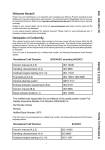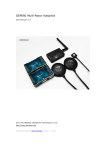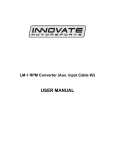Download LMA-3 Multi-sensor Auxiliary Input Device User Manual
Transcript
LMA-3 Multi-sensor Auxiliary Input Device User Manual Auxbox_Manual_1 7.doc 1. Overview................................................................................................................................ 4 Differential Inputs ............................................................................................................... 5 2. The Innovate Log-Chain concept .......................................................................................... 6 2.1 Log-Chain of 5 channels consisting of LMA-3 alone. ........................................................ 7 2.2 Log-Chain of 6 channels consisting of LMA-3 and LM-1 ................................................... 7 2.3 7-channel Log-Chain example with 2 AFR channels......................................................... 7 2.4 17-Channel Log-Chain example ........................................................................................ 7 3. Connecting the LMA-3........................................................................................................... 8 3.1 Connecting the LMA-3 to an LM-1 ..................................................................................... 8 3.2 Using the LMA-3 as part of a Log-Chain ........................................................................... 8 3.3 Connecting external sensor signals................................................................................... 8 3.4 Powering external sensors ................................................................................................ 9 3.5 Connecting an RPM signal ................................................................................................ 9 3.6 Connecting Type K Thermocouples .................................................................................. 9 4. Mounting and calibrating the LMA-3.................................................................................... 11 4.1 Calibrating the Acceleration Sensor to the mounting position ......................................... 11 5. Setting up the input channels .............................................................................................. 12 5.1 Programming the LMA-3 with the setup buttons.............................................................. 12 6. RPM measurement ............................................................................................................. 13 6.1 RPM Measurement basics............................................................................................... 13 6.1.1 Four-Stroke Engines................................................................................................. 13 6.1.2 Two-Stroke Engines ................................................................................................. 13 6.1.3 Rotary Engines (Wankel Engine) ............................................................................. 14 6.2 How the LMA-3 determines RPM .................................................................................... 14 6.3 Programming the RPM input ........................................................................................... 15 6.4 Using the LMA-3 with the Inductive Clamp...................................................................... 16 6.4.1 Inductive Clamp Usage ............................................................................................ 16 6.5 Using the RPM-Converter with pulsed RPM input (Tach) signals ................................... 17 7. Measuring Pressures .......................................................................................................... 17 7.1 Measuring MAP ............................................................................................................... 17 7.2 Measuring boost/vaccum................................................................................................. 17 8. Measuring Ignition Advance ................................................................................................ 18 8.1 Using a GM HEI Module as VR amplifier......................................................................... 20 8.2 Making your own optical reference pulse sensor............................................................. 21 8.3 How the LMA-3 measures ignition advance .................................................................... 22 8.3.1 Measurement Details................................................................................................ 23 9. Measuring Frequencies, custom RPM, or speed ................................................................ 25 10. Measuring duty cycle ........................................................................................................... 25 11. Measuring external 5V sensors........................................................................................... 27 11.1 Calibrating external 5V inputs ...................................................................................... 27 11.1.1 Calibrate using built-in sensor power ....................................................................... 27 11.1.2 Calibrate using external sensor power ..................................................................... 27 11.1.3 Restoring a channel to factory calibration ................................................................ 28 12. Programming the LMA-3 with LM Programmer................................................................... 30 12.1 Changing the device name .......................................................................................... 30 12.2 Updating the firmware .................................................................................................. 31 12.3 Input 1 Configuration.................................................................................................... 31 12.3.1 Measuring RPM........................................................................................................ 31 12.4 Input 2 Configuration.................................................................................................... 32 12.5 Input 3 configuration..................................................................................................... 32 12.5.1 Measuring Custom RPM .......................................................................................... 32 12.5.2 Measuring Frequency............................................................................................... 32 12.5.3 Measuring Speed ..................................................................................................... 33 12.5.4 Measuring Ignition Timing ........................................................................................ 34 12.6 Input 4 configuration..................................................................................................... 35 12.7 Input 5 Configuration.................................................................................................... 35 13. Using the LMA-3 with LogWorks 1.x ................................................................................... 36 14. Revision History................................................................................................................... 37 1.1 -2- -3- 1. Overview The LMA-3, also called the ‘AuxBox’, was originally designed as a peripheral for the LM-1 digital Lambda meter. The LM-1 has 5 auxiliary inputs. The LMA-3 populates these inputs with either built-in sensors or user-connectable external sensors. The LMA-3 may also be used as a standalone 5 channel MTS compatible input device (see Chapter 2 for more details). Each of the five inputs of the LMA-3 can be user configured for different functionalities. The 7-segment display of the LMA-3 (Function indicator) will show which functionality is selected. The following tables show the functionality of each of the 5 inputs of the LMA-3: Input 1 Functions Function Indicator Functionality 1 2 = RPM (0..10230) RPM (0..20460) External 0..5V sensors 1 2 3 4 5 = Thermocouple EGT range (0..1093 degC, 32..1999 degF) Thermocouple CHT range (0..300 degC, 32..572 degF) Side Force (+- 2g ) Side Force (+- 1g) Side Force (+- 0.25g) External 0..5V sensors 1 2 F = Duty Cycle Ignition Timing Frequency (straight frequency, Speed sensor, Custom RPM range External 0..5V sensors Input 2 Functions Function Indicator Functionality Input 3 Functions Function Indicator Functionality Input 4 Functions Function Indicator Functionality 1 2 3 4 F d = MAP (1 bar) (0..101.3 kPa) MAP (3 bar) (0..304.1 kPa) Vaccuum (0..30 inHg Vacc) Vaccum/Boos t (-14.7PSI… 29.4 PSI) Frequency (straight frequency, Speed sensor, Custom RPM range Duty Cycle External 0..5V sensors -4- Input 5 Functions Function Indicator Functionality 1 2 3 F d = Acceleration (+- 2g) Acceleration (+- 1g) Acceleration (+- 0.25g) Frequency (straight frequency, Speed sensor, Custom RPM range Duty Cycle External 0..5V sensors The LMA-3 also can act as a power supply for user supplied external sensors. The 5V output of the LMA-3 can supply up to 300mA of current. For this functionality the LMA-1 must be connected to a switched 12V source in the car. It converts the 12V to 5V to power the sensors. When no external sensors need to be supplied with 5V power, the 12V connection can be left open. 1.1 Differential Inputs The LMA-3’s external connections are differential. This means that each input channel has 2 input terminals. A + terminal and a – terminal. This is to eliminate ground offsets in the signal. Many times the ground point of a sensor is at a different ground than the LMA-3. Because each electronic device can only measure a voltage referenced to it’s own ground, differences in grounding can introduce measurement errors. The LMA-3 measures the sensor signal’s ground with the – input and them measures the difference between the + and the – input. This way it “recreates” the sensor signal’s own ground reference as if this input were referenced directly to that sensor’s ground. The – input is NOT a ground itself. It is a ground reference input. -5- 2. The Innovate Log-Chain concept LogWorks 2.0 has the capability to log, display and analyze up to 32 engine parameters. Most users will use less though. Each of the MTS components reads between 1 and 6 engine parameters. To interface a multitude of MTS components to LogWorks with a single connection, the Innovate LogChain concept was introduced. The LMA-3 can be used as a MTS component in a Log-Chain. Each of the MTS components has two serial ports (except the LM-1, which has only one). One serial port is designated as IN-port, the other as OUT port. The OUT-port of one device is connected to the IN-port of the next device and so on. This way devices can be ‘daisy-chained’ to build a log-chain for up to 32 channels total. The OUT-port of the last device is connected to the computer for logging or downloading of logged data. The device that’s first in the chain is special. It determines the logging sample rate. The first device in the chain sends a data packet containing its channel data (a sample) to the next device (downstream, left to right in the diagram) every 81.92 milliseconds. The next device appends its data to that packet and hands that packet to the next device downstream and so on. At each device the packet grows in length. The devices in the chain synchronize their sampling of the engine parameters to the packets, so that all the channels in a packet together represent the same instance in time. At the downstream end of the log chain (OUT-port of the last device) a computer or external logger can be connected to store or display the stream data. The XD-1 display is such a device. This also means that the complete channel data set is ONLY available at the end of the logchain. A datalogger capable of recording the log-chain data-stream therefore MUST be placed at the end of the log-chain. This includes lap-top computers or other loggers. Commands for individual devices are sent ‘upstream’. A device (incl. a computer or an XD-1) can send commands to the devices upstream of itself, but not downstream. Commands can include start-stop recording, calibration/configuration commands and so on. Only the device directly upstream of the command originator of course will receive the command. This device then decides, depending on the command, whether to execute the command and whether to pass it on. An example of a case where the command is executed but not passed on is the start-stop record command. The first upstream device capable of logging internally will execute the command, but not pass it on. As said before, the first device is special because it is the synchronization source for the entire chain. By plugging its IN-port with the supplied terminator connector, a device can detect that requirement when it powers up. The terminator connector just connects the transmit and receive line of the IN-port together. Each device sends a special command out on it’s IN port when it powers up. This command is ignored and not passed on by any device if received on it’s OUT port. If the sending device immediately receives that command on its IN-port again, because the terminator is plugged in, it assumes it is the first and special device in the chain. The LM-1, having only one serial port, is ALWAYS a special device and MUST be connected to the beginning of the chain. The following are some examples of Log-Chains using the LMA-3 and other MTS devices. -6- 2.1 Log-Chain of 5 channels consisting of LMA-3 alone. 2.2 Log-Chain of 6 channels consisting of LMA-3 and LM-1 This allows to record LMA-3 data in the LM-1. 2.3 7-channel Log-Chain example with 2 AFR channels. Notice that the LC-1’s are connected BEFORE the first LMA-3. LC-1’s should always be connected before the first LMA-3. 2.4 17-Channel Log-Chain example The example chain consists of a LM-1/LMA-2, a LC-1, two LMA-3’s and 2 XD-1’s. In this case the chain has 17 channels (6 from LM-1, 1 from LC-1 and 5 each from the two LMA-3’s). Devices attached to the LM-1’s analog input count as being part of the LM-1’s 6 channels. They don’t count extra. XD-1’s do not contribute any channels, so you can add as many as needed. -7- 3. Connecting the LMA-3 The LMA-3 looks like this: 3.1 Connecting the LMA-3 to an LM-1 Plug the supplied Mini-DIN8 to Mini-DIN8 cable in the LM-1 port of the LMA-3. Plug the other end of the cable into the AUX-IN port of the LM-1. The LMA-3 is now operable and is powered by the LM-1. NOTE: The 5V power supply for external sensors should not be used when the LMA-3 is solely powered by the LM-1. 3.2 Using the LMA-3 as part of a Log-Chain If the LMA-3 is the first device in the Log-Chain, it’s Serial IN port MUST be plugged by the supplied Terminator plug. The Terminator is a 2.5mm Stereo connector with no cable attached. 3.3 Connecting external sensor signals For each external connection you can connect the external sensor’s output to the CHx+ connection. Connect the CHx- connection to the ground of the sensor. Make sure the sensor output signal does not exceed 5V. The LMA-3 is protected if sensor signals exceed that (up to 40V for most inputs), but it cannot measure beyond a 5V signal. -8- 3.4 Powering external sensors If you want to power external sensors, connect a switched 12V supply (switched on when the cars ignition system is on) to the connection marked 12V on the left side. Connect the connection marked GND to the cars chassis ground. At the connection marked 5V you can connect external sensors. External sensors don’t HAVE to be powered by the LMA-3. The 5V output is a convenience for external sensors when no 5V supply is available. The 5V supply can power sensors with a total power consumption of up to 300mA. 3.5 Connecting an RPM signal For RPM measurement you can either connect a tach signal to the CH1+ input or plug an inductive clamp into the 3.5 mm stereo socket marked RPM. See chapter 6 for RPM measurement details. 3.6 Connecting Type K Thermocouples Thermocouples are used to measure temperatures by relying on the phenomena where a junction of any two different metals ( Copper and Iron, for example ) will generate a small voltage. This voltage is dependant upon which two metal are used, and the temperature of the junction. This phenomena is known, formally, as the "Seebeck Effect". Because every junction of different metals contributes its own voltage into the measurement, it is important to have as few junctions between dissimilar metals as possible in order to record an accurate measurement. This is why thermocouple wire is made completely of two different metals. The "Type K" thermocouple included in the LMA-3 kit is composed of Cromel and Alumel; one lead being made of each ( the red and yellow leads ). Do not look in the box for a thermocouple sensor to put onto the end of the thermocouple wire. You can use the wire AS the sensor or use the wires to attach to a Type K thermocouple. To make a thermocouple, strip approximately 3/4" of insulation form one end of the thermocouple wire. Twist the two exposed metal ends together. You may optionally solder them, also. But twist them first. Do not solder them in parallel. This will form what is called the "Hot junction". This "Hot junction" is what you will connect to the surface that you want to measure. This is usually either: a) under the copper gasket of a sparkplug for cylinder head temperature (CHT) or, b) clamped to a primary header tube for exhaust gas temperature (EGT). There is also the "Cold junction." This is where the 2 leads of the thermocouple come together again at the LMA-3 terminals. The LMA-3 has an internal temperature sensor at the T/C input terminals. It uses this sensor to "offset" the effect of the "Cold junction" in the measurement. This is called "Cold junction compensation". Once the effects of the cold junction are neutralized, the LMA-3 can accurately read the temperature of the "Hot junction" which is the twisted lead pair at the opposite end of the thermocouple wire. One thing that is counter intuitive for many people is that the negative side of a thermocouple wire is always red. There are many different types of thermocouple wire; types K, J and T being the most popular. All have a red negative lead and a yellow, black, or blue positive lead respectively. When connection the thermocouple to the TC terminals on the LMA-3, be sure to connect the yellow lead to the + and red lead to the - terminals. Several manufacturers offer EGT "thermocouple probes" which are actually inserted into the exhaust gas stream through a hole in the headers or exhaust manifold. These provide a more accurate measurement of exhaust gas temperature. They are commonly available in types K and J. Only type K will currently work with the LMA-3. To use a thermocouple probe, connect the red -9- and yellow leads of the thermocouple wire to the yellow and red leads of the thermocouple probe. The junction is inside the probe. You can not use normal copper wire to connect the thermocouple probe to the LMA-3. You must use thermocouple wire to connect the probe. If you do not, there will be an extra two-metal junction where the Copper wire meets the Constantan wire of the probe. This extra junction will cause a large error in the temperature readings. Most Thermocouple probes are of the “grounded junction” type. This means that the “hot junction” is also connected to the probe’s body. As this body is connected for example to the exhaust manifold, the sensor wires are essentially grounded through that. The same is true if a homemade thermocouple junction is used as described above by twisting the wires and if that wire-twist is connected to some grounded engine part. You can check if you have a grounded junction type by measuring between the probe body and one of the Thermocouple wires. If you have continuity, you have a grounded junction. The LMA-3 NEEDs a grounded junction. If you don’t have a grounded junction, connect a wire between the TK- input of the LMA-3 and the ground terminal of the LMA-3. - 10 - 4. Mounting and calibrating the LMA-3 In order to use the acceleration sensor of the LMA-3, care must be taken to mount the LMA-3 correctly on a horizontal surface in the car. The LMA-3 MUST be aligned with the direction of travel. The following pictures show the four possible mounting positions. The mounting position should not deviate more than 3 degrees from horizontal. 4.1 Calibrating the Acceleration Sensor to the mounting position Lay the LMA-3 down on the mounting surface, but don’t mount it yet. Switch the LM-1 on to power the LMA-3 or switch the 12V supply to the LMA-3 on if it is powered from a switched 12V supply. Press the ‘Calibrate’ button until the digit display shows a blinking C If the mounting surface is not within the 3 degrees of horizontal, the acceleration sensor can’t be calibrated for zero g and the LMA-3 shows a blinking E for Error: After the zero g acceleration calibration is performed, hold the LMA-3 such that the side of the LMA-3 pointing in the intended direction of travel points vertically up. Then press the Calibrate button again until the blinking C shows up. If the LMA-3 shows the blinking ‘E’, even when the device is calibrated on a flat, horizontal, surface, the device may need to be reset. To reset the LMA-3’s accelerometers, place the device on a flat, horizontal, surface and press and hold all three buttons together until the display shows the letter ‘A’: After this, re-try the above calibration procedure. You can now mount the LMA-3. - 11 - 5. Setting up the input channels The LMA-3 can be programmed directly through the setup buttons on the LMA-3. LM Programmer software version 3.05 (or later) allows you to program the LMA-3 via the LM Programmer software. This is necessary for some of the more advanced functionality of the LMA-3. Some of these advanced functions like speed sensing, frequency sensing, custom RPM, ignition advance and so on require more user input data that cannot be supplied by the simple 3-button interface of the LMA-3. 5.1 Programming the LMA-3 with the setup buttons To program an input channel, repeatedly press the ‘Channel’ button until the channel number to program appears on the LMA-3 digit display. Then repeatedly press the ‘Function’ button until the digit display shows the intended function. The digit display will switch rapidly between indicating the input channel number and the set function. The LEDs next to the channel and function buttons will indicate which value is being displayed. If the function selected is External input, the digit display shows a ‘=’ sign like this: Refer to Chapter 1 for the different functions for the inputs. - 12 - 6. RPM measurement 6.1 RPM Measurement basics Most RPM measurement methods use the ignition system of the car as a convenient source of RPM dependent pulses. Other methods use a TDC sensor (one pulse per rotation), cam sensor, or fuel injection pulses (number of pulses/rotation is dependent on the fuel-injection system). Some actually measure the AC frequency created by the car's alternator. Because the number of pulses per crank rotation is dependent on the ignition system and engine type, a universal RPM measurement method must be adaptable to the different environments encountered. The typical ignition system consists of an ignition coil, a coil driver that switches current to the coil on and off, and a distributor. When current is switched on to the coil, the coil stores energy in its magnetic field. When the current is switched off, that energy gets discharged at a very high voltage pulse on the coil’s secondary winding, creating a spark. A capacitive discharge ignition system (CDI) uses a capacitor to store the spark energy. The capacitor is charged to about 400V and then rapidly discharged over the ignition coil's primary winding. The coil thus only acts as transformer and does not store energy (and can therefore be smaller). The advantage of a CDI system is a very high and fast rising spark voltage (less susceptible to spark fouling). The weakness of the CDI system is the very short duration spark, which might not be long enough to ignite the mixture. Multispark ignition systems try to overcome the inherent weakness by creating multiple spark pulses over some degrees of crank rotation to increase the likelihood of igniting the mixture. The distributor switches the spark voltage to the appropriate spark plug. 6.1.1 Four-Stroke Engines On a typical 4-stroke engine each spark plug fires once for every two crank rotations. The coil on a distributor-equipped 4-stroke has to create sparks for every cylinder. The number of ignition pulses per crank rotation in this case is the number of cylinders divided by 2. Some engines have one coil for every 2 cylinders instead of a distributor. The coil fires two spark plugs at the same time. One spark is wasted because it fires one cylinder at the end of its exhaust stroke. Therefore, this system is called a Waste Spark System. Each coil of a Waste Spark System fires once for every crank revolution. Other distributor-less 4-stroke engines use one ignition coil for every spark plug. This ignition system fires each coil once for every 2 crank revolutions. Coil-on-Plug ignition systems actually incorporate the ignition coil in a module that plugs directly onto a spark plug and do not have a spark plug wire. 6.1.2 Two-Stroke Engines On a 2-stroke engine there is a spark for every crank rotation, so the spark frequency doubles compared to a 4-stroke.Very few multi-cylinder 2-strokes have distributors. For those that do, the number of ignition pulses per crank rotation is equal to the number of cylinders. Most two-stroke engines have one coil for every cylinder. The coil fires once for every crank revolution, the same as on a 4-Stroke Waste Spark system. - 13 - 6.1.3 Rotary Engines (Wankel Engine) A rotary engine consists of a roughly triangle shaped rotor rotating in a roughly elliptical chamber. The three spaces left between the chamber and the rotor go through the four cycles of a fourstroke engine for each rotation of the rotor. A single (or dual) spark plug at a fixed position in the chamber ignites the mixture of each space in sequence. Therefore, a rotary engine requires 3 sparks for every rotation of the rotor. The mechanical power from the rotor is coupled to an eccentric gear to the output shaft. This gear has a 3:1 gear ratio and the output shaft therefore rotates 3 times faster than the rotor. The output shaft is the equivalent of the crankshaft on a piston engine. Because RPMs are measured conventionally as the rotations of the crankshaft, the rotary engine requires one spark for every 'crankshaft' rotation, the same as a two-stroke engine. 6.2 How the LMA-3 determines RPM The LMA-3 measures RPM not by measuring the number of pulses over a time period, as a tachometer does. That measurement would be too slow to provide adequate correlation between input channels. Instead the LMA-3 measures the time between input pulses and from that calculates RPM for each pulse measurement. This measurement method has a few caveats though: 1. If the RPM pulse signal is derived from the ignition signal, a multi-spark ignition system will trigger the measurement multiple times for each pulse. This throws the measurement off because the LMA-3 does not know if the pulses are for each ignition event (one per cylinder cycle) or because of multispark. This is specially problematic because the number of multispark pulses also varies with RPM in a lot of ignition systems. Fortunately many multispark ignition systems output a tach signal with only one pulse per engine cycle. But some, notably Ford EDIS systems, output all pulses and therefore require a special tach adapter. 2. Odd fire engines, like V-Twin motorcycle engines and odd-fire V6 engines have ignition pulses that are not evenly spaced. For example a 60 degree V-Twin running at 10 degrees ignition advance will fire cyl. 1 at 10 degrees BTDC. Then fire cyl. Two 420 degrees later at 410 degrees. Then fire cyl 1 300 degrees later at 710 degrees. This means the ignition pulses sent to the LMA-3 are alternating between 420 and 300 degrees apart and therefore the time between pulses alternates. The LMA-3 therefore measures the times between ALL pulses for a complete engine cycle (2 rotations) and averages the times between them. - 14 - 6.3 Programming the RPM input - Determine the number of ignition pulses per crank rotation. Refer to Table 2 or 3 for guidance. - Press the ‘Channel’ button until it shows channel 1. - Press the ‘Function’ button until it shows 1 or 2. Use 1 if your engine’s redline is below 10000 RPM. Otherwise use 2. - Press the ‘Calibrate’ button until the selected Cyl. Number apears Table 2: Cylinder number and RPM calibrate number 4 Cyl engine Number of Cylinders 4-Stroke pulses/CrankRotation Calibrate Number Comment 1 1/2 1 2 1 2 Use also when using inductive clamp on spark wire or power wire of COP system of 1 cylinder only for all cylinder numbers Use also when using inductive clamp on spark wire or power wire of Waste spark coil of 1 cylinder only. Waste spark system: 1 coil for every 2 cylinders. 3 4 5 6 8 10 12 1-1/2 2 2-1/2 3 4 10 12 3 4 5 6 8 A C Table 3:: Cylinder number and RPM calibrate number 2 Cycle and Rotary Engine Number of Cylinders 2-Stroke pulses/CrankRotation Calibrate Number Comment 1 1 2 2 2 4 Use also when using inductive clamp on spark wire or power wire of COP system of 1 cylinder only for all cylinder numbers Also use for rotary engine. Use also when using inductive clamp on spark wire or power wire of Waste spark coil of 1 cylinder only. Waste spark system: 1 coil for every 2 cylinders. 3 4 5 6 3 4 5 6 6 8 A C - 15 - 6.4 Using the LMA-3 with the Inductive Clamp The inductive clamp measures the magnetic field created around a spark plug wire when spark current flows. If a metallic shield covers the spark plug wire, the inductive clamp may not work because the shield would short out the magnetic field. Like all inductive clamp rpm pickup devices, some ignition systems like Capacitive Discharge Ignition (CDI) or multi-spark ignition systems may not work properly with the inductive clamp pickup because the pulses created may be too short in duration. Multi-spark systems confuse the ignition timing measurement because the RPM converter cannot distinguish which ignition pulse belongs to which crank rotation. The LAM-3 will work only on the tach output of the ignition system in this case. The inductive clamp must be clamped around ONE lead only. Clamping it (for example) around all wires of a coil-on-plug pack does not allow it to work because the magnetic fields of the wires most likely cancel each other out. 6.4.1 Inductive Clamp Usage - Plug the inductive clamp's 3.5mm audio plug into the RPM socket of the LMA-3. - Clamp the Inductive Clamp on the spark plug wire of one cylinder so the wire is completely surrounded by the clamp. - Make sure the clamp is completely closed. - Start the engine. - Switch on the LM-1 unit. The decimal point of the digit display of the LMA-3 should light up steadily. This indicates when a valid RPM signal is detected. If it does not light up, or lights up intermittently, reposition or reverse the clamp (try clamping it upside down). If the decimal point out only occasionally, that is OK. The RPM converter will still convert, though its output might be noisy. A noisy output has spikes or lengthy flat areas in the data log. [Note: to work properly with the inductive clamp pickup the LMA3 must be set up for the appropriate number of pulses per crank rotation.] • For a 4 stroke engine without waste spark ignition, this would be 1 pulse per 2 crank rotations. This is the factory setting. • For a 4 stroke engine with waste spark ignition, or a 2 stroke engine, this would be 1 pulse per crank rotation. • For a rotary engine, this would be 1 pulse per rotation. This is the same as for a 1-cyl 2-stroke motor. Note: On any distributor-less ignition system you can alternately clamp the inductive clamp around one of the power wires on the primary side of the ignition coil or coil-onplug module. - 16 - 6.5 Using the RPM-Converter with pulsed RPM input (Tach) signals - Unplug the inductive clamp from the LMA-3 if connected. - Connect the RPM signal to the CH1+ input screw terminal. The decimal point of the digit display of the LMA-3 should light up steadily. This indicates when a valid rpm signal is detected. If it does not light up, check your connections. DO NOT CONNECT A PULSED RPM SIGNAL TO THE INDUCTIVE CLAMP INPUT. THIS MIGHT DAMAGE THE LMA-3 OR LM-1. Again, this should just result in an error code, not mechanical damage. 7. Measuring Pressures The LMA-3 has a built in MAP sensor. To use it, connect a small ¼” hose between a vacuum/boost connection AFTER the throttle body and the LMA-3 MAP input port. It should be connected after the throttle body because the lowest pressure that can be measured before the throttle body is atmospheric pressure (discounting some pressure losses from the intake tract before the throttle body). MAP stands for Manifold Absolute Pressure. This means that the sensor measures pressure referenced to absolute vacuum, not atmospheric pressure like many vacuum and boost gauges. Engine parameters like fueling, ignition timing, compressor efficiency and so on are dependent on the MASS of air (in pounds per cubic foot or kg per cubic meter) entering the engine. As air is a gas, it’s mass is dependent on it’s ABSOLUTE pressure, referenced to absolute vaccuum and it’s temperature. Most vaccuum and boost gauges are gauge pressure sensors. A gauge pressure sensor measures the difference to atmospheric pressure, not the absolute pressure. So, without knowing atmospheric pressure at the point where the sensor gets it from, the actual air-mass entering the engine can’t be measured. Because the atmospheric pressure changes with altitude and weather, the gauge pressures are not a precise metric. This is specially problematic for boost pressure sensors, because their atmospheric reference source comes typically from inside the cabin or engine compartment. The atmospheric pressure there can change with speed from aerodynamic effects (ram pressure). 7.1 Measuring MAP Function 1 of input 4 of the LMA-3 measures absolute pressure with a range of 0..1 bar (0..14.7 PSIa). This is the range intended for normally aspirated engines where the maximum intake pressure can be atmospheric pressure. Function 2 of input 4 of the LMA-3 measures absolute pressure with a range of 0..3 bar (0..44.1 PSIa). This is the range intended for boosted engines where the maximum intake pressure can be up to 29.4 PSI above atmospheric pressure. 7.2 Measuring boost/vaccum The LMA-3 can use it’s MAP sensor also as gauge pressure sensor if so desired. As stated above, this is NOT the preferred way of measuring pressures, but it is possible. The LMA-3 will measure the current atmospheric pressure in the intake tract when it starts up and stores this - 17 - value internally until it is started the next time. In vaccuum/boost measurement mode the LMA-3 will then subtract the measured value from the MAP value internally. For this to work, the LMA-3 MUST be powered by a switched 12V source that switches on before the engine is started, like the ignition power. This 12V source MUST stay active during cranking. To give the LMA-3 a chance to measure atmospheric pressure, you must change the way you start the engine. First, switch ignition on (powering the LMA-3), wait for 0.5 seconds, THEN crank the engine (starter). Function 3 of input 4 of the LMA-3 measures vaccuum with a range of 0..30 inHg (gauge) This is the range intended for normally aspirated engines where the maximum intake pressure can be atmospheric pressure. Function 4 of input 4 of the LMA-3 measures vaccuum and boost pressure with a range -14.7 to 29.4 PSIg This is the range intended for boosted engines where the maximum intake pressure can be up to 29.4 PSI above atmospheric pressure. Vaccuum is typically measured here as negative PSI. But you can set up any metric you want with LogWorks 2. 8. Measuring Ignition Advance Warning: Measuring ignition advance is NOT a simple plug-and-play process. The variables are many and you need to know what you are doing to do it right. Read this chapter multiple times before attempting this and try to understand what you are measuring. The LMA-3 expects the spark reference pulse on input 1 and the crank reference pulse on input 3. Input 1 is simultaneously still used to measure RPM, but MUST be set to measure RPM. The LMA-3 can measure ignition advance between 10 degrees ATDC to 50 degrees BTDC. ADTC numbers will be negative, BTDC numbers will be positive. The LogWorks equivalents are 0V = 50 degrees, 5V = -10 degrees. Ignition advance is typically measured in degrees. This is the number of degrees before Topdead-center of a piston where the spark fires. When the spark in an engine fires the mixture in the combustion chamber starts the burn process. Because it takes time for the fire to consume the mixture, it has to be lighted before the piston hits top dead center. During that burning process the pressure and temperature rises. The pressure and temperature rise results not only from the energy released by the burning mixture, but also the piston is still moving up, compressing the burning gas. At some point in this process the pressure in the cylinder peaks and then falls off. The position of this pressure peak (in crank angles) depends on the engine geometry (bore-stroke ratio, stroke-rod length ratio and so on), but NOT on engine load or RPM. For many engines the ideal peak pressure position to extract the maximum energy is between 14 and 20 degrees ATDC. The time the mixture takes to burn is dependent on many variables. AFR, mixture density, temperature and so on are some of the variables. The point of ignition advance is to time the spark such, that the peak pressure point is reached at the ideal position. Earlier or later looses power. An engine typically does not have a “crank degree” sensor output of sufficient resolution. Therefore ignition advance must be measured as a time measurement. An engine crankshaft - 18 - rotates at 360 degrees per revolution. So, by measuring the time between the spark pulse and a reference pulse, the ignition advance time can be calculated. For example if the reference pulse is at a 90 degree crank angle and the spark happens at 20 degrees BTDC at 6000 RPM, the engine rotates at 36000 degrees per second. So, the time difference between spark pulse and reference pulse is 0.003055 seconds. Most modern EFI systems have trigger wheels that create reference pulses through a hall effect or variable reluctance sensor. These trigger wheels look like toothed gears with one or two teeth missing (some instead have extra teeth). Some systems also have only a single magnetic trigger reference from the flywheel or balancer and use the starter ring gear to provide extra pulses. The extra pulses are needed by the ECU to determine the exact crank angle when to fire the sparks for the different cylinders. The LMA-3 is not concerned with firing multiple cylinders, but only with the timing of one cylinder (typically cylinder 1). Therefore it does not need the additional pulses, but can identify the reference trigger from each. Another concern is the “phase” of the pulses. The timing can be measured either from the rising or falling edges of the spark pulse to the rising or falling edges of the reference pulse. Which pulse edge for each has to be known to allow accurate measurement. Very often this can be only determined by trial and error. This means you have to go through all four possible combinations until you measure the correct advance, verified with a timing light. For this reason the use of the inductive clamp as RPM source is NOT recommended for spark advance measurement, because its phase is undetermined can changes depending on which way around you use the clamp. For example if the source for the spark pulse is the negative side of the ignition coil (inductive ignition), the negative side of the coil goes to ground (negative edge of pulse) to charge the coil. When the coil discharges (spark happens) the voltage rises to several hundred volts and then returns to 12V. In this case the spark pulse would use the rising edge. The same is true for the trigger pulse from the trigger wheel. Depending on the sensor used, the output pulses can be negative or positive. This can either be found out with an oscilloscope or by programming the LMA-3 for one way or the other and finding out which is the correct one. The tryout should be done at different RPMs, because under some circumstances you could get a correct reading at idle, but a shift at a different RPM. NOTE: Variable reluctance sensors cannot be read by the LMA-3. VR sensors do not output a clean pulse, but a short wave, whose 0 Volt crossover is measured. The wave amplitude is dependent on RPM and sensor. For these applications a special VR amplifier like the LM1815 needs to be used. Example voltage trace of a VR sensor output: Example output of a VR sensor amplifier: - 19 - As one can see, the reference pulse created would have a positive edge. 8.1 Using a GM HEI Module as VR amplifier You can also use a simple 4-wire GM HEI module to pick up the pulses from an existing VR sensor. Those were used on many non-computerized GM cars from 1975 to the mid 1980s. The VR sensor’s + wire needs to be connected to the W terminal of the HEI module, the – side to the G terminal. Connect a switched 12V power supply to the B terminal and connect a 390 Ohm 1/2W resistor between B and C terminal. The C Terminal goes also to the LMA-3s CH3+. Ground the LMA-3s CH3- terminal. NOTE: The metallic bottom of the GM HEI module needs to be connected to a solid ground. The HEI module will create a positive pulse edge (rising) when a tooth from the tooth wheen passes (center of tooth). - 20 - 8.2 Making your own optical reference pulse sensor The device to be used is a Fairchild reflective optical sensor type QRC1133. This device contains a infrared LED to shine an infrared light beam on a mark on the balancer or flywheel and also contains a photodiode to detect the reflected light. The device can be ordered from: www.digikey.com Part Number QRC-1133-ND. This device looks like this: To use it you also need two resistors (1/4W). One resistor is 330 Ohm, the other 3.3 kOhm. The hookup schematic to be used is this: - 21 - Paint the balancer or flywheel surface flat black so as not to reflect any light. Then paint a ¼” to 1/3” (6-9 mm) white stripe on the balancer or flywheel at 90 degrees after TDC. The edge of the stripe in rotation direction should be at the 90 degree mark. The sensor should be mounted at TDC where the TDC mark is when the engine is at TDC. The device will output a pulse with the NEGATIVE edge at the 90 degree mark. Mount the device so that its front edge is about 0.15” (3.8 - 4 mm) from the flywheel/balancer. The LED shines infrared light on the flywheel balancer, but the light is absorbed by the black surface. So the photo detector in the device is off and the CH3+ connection should be between 3 and 5V. If the voltage is lower, replace the 3.3 kOhm resistor with a lower value, but don’t go below 1 kOhm. When the LED shines on the white stripe, light is reflected and the photo detector is on, drawing current through the 3.3 kOhm resistor. The voltage at the CH3+ connection should be less than 1 Volt. If the voltage is higher, replace the 3.3 kOhm resistor with a higher value. 8.3 How the LMA-3 measures ignition advance Ignition Advance is how many crank degrees before (or after) TDC the ignition fires. This means the measurement system must know where TDC is and when the spark fires. There’s no sensor on a car that directly measure crankshaft degrees. Therefore the LMA-3 needs to measure RPM and the time difference between the TDC mark and the ignition firing. Example: - 22 - At 6000 RPM an engine rotates 100 times/second. This means the crankshaft rotates 36000 degrees per second. So, if the spark fires 1 millisecond before TDC, the ignition advance is 36000 th degrees/sec times 1/1000 second, or 36 degrees. 8.3.1 Measurement Details To determine advance, the LMA-3 uses RPM and the time it takes the reference tooth to pass by. It passes by once per revolution. The reference tooth is either the tooth after the missing tooth (or teeth) on a missing-tooth trigger wheel, the extra tooth on a extra-tooth trigger wheel or simply the mark tooth if only one tooth wheel or mark is used (called the Redneck Trigger, because it has only one tooth). For this to work, the RPM signal on Input 1 MUST have either a negative edge or positive edge when a spark happens. A RPM signal on Input 1 that is derived from a trigger wheel without spark offset, can’t be used. This is often the case if an RPM signal generated by an ECU, is used. In that case the RPM signal needs to be tapped of the coil negative or the ignition drive signal. In the case of getting the RPM signal from coil negative, typically a positive edge happens when the coil fires. This assumes a regular inductive, not a CD ignition system. CD ignition systems typically do have an RPM output, but the polarity of the pulse (which edge coincides with the spark event) is depending on the manufacturer and device model. On some dwell controlled ignition systems, like GM HEI, very often a potentiometer needs to be used to attenuate the RPM signal so only the TRUE spark event is measured, not other edges in the waveform. Below is an expample on how to connect such a potentiometer: The importance of programming the correct pulse edge for both, the TDC reference signal and spark signal is illustrated below: We assume a 8 tooth trigger wheel (teeth 45 degrees apart) with one tooth missing. The wheel is installed with the missing tooth at 180 degrees from TDC, the VR sensor is mounted at 90 degrees after TDC as in this illustration: - 23 - From this we know that the missing tooth (number 8) passes by the VR sensor at 90 degrees BTDC. The missing tooth is 180 degrees before TDC. The VR sensor is offset from that in counter-rotating direction by 90 degrees, so 180 – 90 = 90. Tooth number 1 can’t be used as opening tooth, because it passes by 45 degrees BTDC. Tooth number 8 can’t be used because it’s not there. So tooth number 7 is used. It passes by 135 degrees BTDC. Now let’s look at the pulses that the LMA-3 would see at 6000 RPM. We asume a tach pulse width of 1 msec, spark at TDC. Tooth reference pulse edge is positive (rising edge) and tach reference pulse has a positive edge at the spark event. The example shows a 2 cylinder engine with one spark at every spark event. The “measurement window” (range) is shown in gray. One can clearly see that the falling edge of the tach signal is outside the measurement window. If for example the tach signal contains the spark signal of all sparks of an 8 cylinder engine, the spark event of cyl. 8 instead of cyl 1 could fall into the measurement window and the measurements would be off. The following example shows what would happen if the wrong edge of the trigger wheel signal is used: - 24 - One can see that the measurement window is shifted by the width (or time duration) of the Trigger wheel pulse. Because in most cases that pulse width is fixed, the error translates to varying number of degrees depending on RPM. To set up the ignition measurement system of the LMA-3 with unknown edge trigger signals, all four possible cases should be examined and verified with a timing light at at least 2 different RPMs: Case 1 Case 2 Case 3 Case 4 Trigger pulse positive edge Trigger pulse positive edge Trigger pulse negative edge Trigger pulse negative edge Spark reference positive edge Spark reference negative edge Spark reference positive edge Spark reference negative edge 9. Measuring Frequencies, custom RPM, or speed The LMA-3 has the capability to measure frequencies on channels 3, 4, and 5. It converts a frequency signal (pulses per second) into a voltage (0..5V) to be logged in the LM-1 or a number between 0 and 1023 to be logged directly by LogWorks. This is useful for measuring custom RPM ranges, signals from speed sensors or the frequency of MAF sensors with frequency output (as opposed to voltage output MAF sensors). The range of frequencies that the LMA-3 can measure can be programmed by with LM Programmer. The LMA-3 can be set to any frequency range between 0 and 30 Hz for the full 0..5V range to 0..15 kHz for the full 0..5V output (logging) range. Also, LM Programmer has convenient conversions built in, so you don’t have to calculate the resulting frequency ranges for speed sensing or RPM sensing yourself. See chapter 10.x for details. A frequency input signal must have an amplitude (voltage range of pulse) between 0.5V at the low pulse point to minimum of 3V and maximum of 40 V at the high pulse range. NOTE: The custom RPM feature will work only for even fire tach signals, not for tach signals that vary their time between pulses during an engine cycle. Use the input 1 RPM functions instead. 10. Measuring duty cycle To measure the duty cycle of a signal in channels 3, 4, and 5, the input signal must cover the same voltage range as for a frequency signal. Duty cycle is defined as the ratio between the time a signal is active and the total time of the active and inactive time. A signal can be either active high ( the event, like injector open, happens when there is a high voltage) or active low (the event happes when the measured signal is at ground or close to it). Very often the injector duty cycle is to be measured by the LMA-3. A typical fuel injector is connected to 12V on one side, while the other side is connected to ground when the ECU opens the injector. Because the pulse is therefore active when the voltage on the pin is at ground, negative duty cycle is measured. - 25 - So called peak-hold injectors (as opposed to saturated injectors), work differently. Their drive signal first goes to ground for a high current opening pulse, then rises to 8-10 Volts for the hold period. Because the LMA-3 sees everything above 2.5V as “high”, it will be able to see only the peak period. On some peak-hold systems it is possible to connect the CHx+ input of the LMA-3 to 12V at the injector and connect the CHx- input to the injector signal to still measure correctly. But that is not always the case. The LogWorks 2.0 Manual shows an alternative method. If the above method works, it actually measures positive duty cycle. - 26 - 11. Measuring external 5V sensors Each of the 5 channels on the LMA-3 can be configured to accept input from an external 0..5V sensor. Hookup is very straight forward, with ground going to the ‘-‘ input for the channel and the positive sensor signal going to the ‘+’ input for the channel. Raw sensor data can be converted into meaningful units and values using the input configuration features of LogWorks on a PC. 11.1 Calibrating external 5V inputs LMA-3 external inputs are factory calibrated. However, depending on a number of factors it is not unusual to see a small discrepancy between values read on an external voltmeter and those read by LogWorks from an LMA-3. If higher precision is required, the LMA-3 can be field calibrated. The following calibration instructions all assume that the input being calibrated has already been configured for external input. Either using LM Programmer or the front panel interface. 11.1.1Calibrate using built-in sensor power In order to calibrate using the built-in sensor power, the following steps must be taken. • Connect the LMA-3 to external 12V power • Connect a jumper wire between the 5V sensor output and the ‘+’ terminal for the input to be calibrated • Press the Channel button until the channel number to be calibrated is displayed • Press and hold the Calibrate button while the channel number is still displayed The LMA-3 will either display a lower case ‘c’ to indicate the Calibration has occurred for the selected channel or an upper case ‘E’ to indicate that the calibration could not occur. Normally an E indicates that the voltage being input is .1V or more off from 5V. 11.1.2Calibrate using external sensor power In order to calibrate using external sensor power, the following steps must be taken. - 27 - • Connect the ground from the external sensor supply to the GND connection on the LMA-3 • Connect the +5V from the external sensor supply to the ‘+’ input of the channel to be calibrated • Press the Channel button until the channel number to be calibrated is displayed • Press and hold the Calibrate button while the channel number is still displayed The LMA-3 will either display a lower case ‘c’ to indicate the Calibration has occurred for the selected channel or an upper case ‘E’ to indicate that the calibration could not occur. Normally an E indicates that the voltage being input is .1V or more off from 5V. 11.1.3Restoring a channel to factory calibration In order to restore an external input back to the factory default calibration, the following steps must be taken. • Connect a jumper wire from the ‘+’ input of the channel to be restored to the GND connection on the LMA-3 - 28 - • Press the Channel button until the channel number to be calibrated is displayed • Press and hold the Calibrate button while the channel number is still displayed The LMA-3 will either display a lower case ‘d’ to indicate the defaults have been restored for the selected channel or an upper case ‘E’ to indicate that the restoration could not occur. Normally an E indicates that more than .1V is being detected on the selected input. - 29 - 12. Programming the LMA-3 with LM Programmer To connect the LMA-3 for programming follow these steps: 1. Insert the terminator plug (included 2.5 mm stereo connector without wire) into the Serial IN port. Make sure it is seated fully. 2. Connect the 2.5mm to DB 2 computer interface cable into the Serial OUT port. Your computer needs a serial port. If it does not have one, you will need a USB to serial adapter. 3. Power the LMA-3 either from 12V, a 9V battery or by connecting it to an LM-1 as described in chapter 3.1. 4. Start the LM Programmer application The following screen will show up: The LM Programmer software then shows in its first page the type and version number of the firmware of the device. 12.1 Changing the device name If multiple LMA-3’s are used in a Log-Chain, each MUST be given a unique name so that LogWorks can identify each LMA-3. Just enter a name in the edit box in this page. - 30 - 12.2 Updating the firmware Click on the ‘Update Firmware’ button. You will be presented with a file dialog box that allows you to select a firmware file. Firmware files end with the file extension .dld. LMA-3 firmware file names start with: AUXB1 for AuxBox 1. The first part is followed by a dash, then a V, then the version number without dots. Example: LMA-3 firmware version 1.00 alpha release would have the file name AUXB1-V100A.dld LAM-3 firmware version 1.00 would have the file name AUXB1-V100.dld After you opened the firmware file, this new firmware will be downloaded in the LMA-3 device. 12.3 Input 1 Configuration Click on the Input 1 tab in the top of the window. 12.3.1 Measuring RPM The drop-down list at the top of the window allows you to select the different functionality for that input. If RPM is selected, the area below the functionality selection shows as above. The positive edge/negative edge selection is ONLY important if this input is also used as spark reference signal for ignition advance measurement. Select the cylinder count in the appropriate drop-down list. - 31 - 12.4 Input 2 Configuration Function 1 and 2 of Input 2 use the TK+ and TK- inputs. The CH2+ and CH2- inputs are used ONLY of this input is set for “external 0..5V sensor” When selecting one of the side-force modes for Input 2, the center window looks like this: Select the travel direction of the car. Please note that changing this setting will effect the travel direction setting for acceleration measurements on Input 5 as well. 12.5 Input 3 configuration Input 3 has by default duty cycle measurement as function 1. See chapter 10 for details. Duty Cycle measurement is also available on Inputs 4 and 5. 12.5.1Measuring Custom RPM When using the custom RPM feature the center area looks like this: On the left edit box you can specify the max RPM for this measurement channel. In the example case the max RPM is 6000. This means that in LogWorks 6000 RPM is equivalent to 5Volt. This allows LogWorks to have a higher RPM resolution (~ 6 RPM per step instead of 10 RPM when the range is 0..10230 RPM). This functionality is also available for Inputs 4 and 5. 12.5.2 Measuring Frequency The center section of the window changes to this: - 32 - You can enter any frequency between 10 Hz and 15000 Hz as full scale frequency. LMA-3 measures the frequency with a resolution of 0.1 % of the full scale frequency specified. So in LogWorks 0 Hz is always 0 Volt, and the full-scale frequency is equivalent to 5 Volt. This functionality is also available for Inputs 4 and 5. 12.5.3 Measuring Speed Select the Speed sensing function in the topmost drop-down list. The center section of the window changes to: With the radio buttons you can select to use metric (km/h) or US (mph) units. In the left drop-down list you select the max speed to be measured. The LMA-3 measures the speed with a resolution of 0.1 % of the selected max speed. In the right edit box you enter the pulses per mile the speed sensor produces. Speed sensors are typically pulse sensors mounted either on the drive-shaft or wheel. To calculate the pulses per mile (or km/h) click on the calculate button: - 33 - Select if you use a drive-shaft sensor or a wheel sensor. Enter the pulses per rotation created by the sensor either as driveshaft rotation or wheel rotation. You also need to enter the wheel diameter, and in case of a drive-shaft sensor, the final drive (differential) ratio. The LM-Programmer will calculate the pulses per mile (km) for you. This functionality is also available for Inputs 4 and 5. 12.5.4Measuring Ignition Timing When selecting ignition timing (See chapter 9 for details) for input 3, the center of the window changes to this: Select the trigger wheel characteristics. The trigger tooth is the tooth after the last missing tooth (if missing teeth), or the extra tooth when the wheel has extra teeth. If only one pulse is used, the missing teeth/extra teeth input is ignored. To enter the offset in degrees, measure the offset (in degrees) after TDC after the last missing tooth. Also measure the offset of the sensor from TDC. Subtract the sensor offset from the tooth offset to get the real offset of the Trigger tooth to be entered. The following picture shows an example: - 34 - In this case the offset of the Trigger Tooth is 100 degrees (after TDC in rotation direction). The sensor is mounted at 45 degrees after TDC. So the complete real offset from TDC is 55 (100 – 45) degrees after TDC. To measure ignition advance, Input 1 MUST be configured for RPM measurement. 12.6 Input 4 configuration Function 1,2,3 and 4 on this input are used for pressure measurement. See chapter 7 for details. For Custom Frequency, Custom RPM, speed sensing and duty cycle inputs on Input 4, see chapter 12.5 12.7 Input 5 Configuration For Custom Frequency, Custom RPM, speed sensing and duty cycle inputs on Input 5, see chapter 12.5 When selecting one of the acceleration measurement modes for Input 5, the center of the window changes to this: Select the travel direction of the car. Please note that changing this setting will effect the travel direction setting for side force measurements on Input 2 as well. - 35 - 13. Using the LMA-3 with LogWorks 1.x When using LogWorks 1.1 (or 1.11), some of the AuxBox default settings are different from the actual LMA-3. For those input channels on the LMA-3 that are not correctly handled, use the Custom setup function of LogWorks to set the channel up correctly. The following table shows how. LogWorks Version 2 handles the LMA-3 default settings correctly Input Channel Function 1 Function 2 1 0..10230 RPM (LogWorks is correct) 2 0..1093 deg C or 32..2000 deg F Thermocouple EGT range (LogWorks is correct) 0..20460 RPM (LogWorks is correct) 0..300 deg C or 32..572 deg F Thermocouple CHT range (LogWorks is correct) 3 Dwell 0..100% (LogWorks is correct) Manifold absolute pressure (normally aspirated) 0..101 kPa or 0..14.7 PSI or 0..1 bar (LogWorks is correct) 4 5 Set as Custom -2g = 0V +2g = 5V Or -19.62 m/sec^2 = 0V +19.62 m/sec^2 = 5V Or -64.37 ft/sec^2 = 0V +64.37 ft/sec^2 = 5V Function 3 Set as Custom 0 kPa = 0V 304 kPa = 5V Or 0 PSI = 0V 44.1 PSI = 5V Or 0 bar = 0V 3 bar = 5V Set as Custom -1g = 0V +1g = 5V Or -9.81 m/sec^2 = 0V +9.81 m/sec^2 = 5V Or -32.18 ft/sec^2 = 0V +32.18 ft/sec^2 = 5V Function E User defined custom settings User defined custom settings User defined custom settings User defined custom settings Set as Custom -0.25g = 0V +0.25g = 5V Or -2.45 m/sec^2 = 0V +2.45 m/sec^2 = 5V Or -8.05 ft/sec^2 = 0V +8.05 ft/sec^2 = 5V - 36 - User defined custom settings 14. Revision History 1.0 -- 8/23/04 Initial release. 1.1 -- 8/31/04 Corrected miscellaneous typographical errors. 1.2 -- 9/1/04 Corrected table 1 and section 6. 1.3 -- 9/20/04 Corrected miscellaneous typographical errors. 1.4 -- 8/19/2005 Changed to reflect functionality of firmware 1.1. 1.5 – 8/22/2005 Changes: Added 3-button Accel reset to 4.1 ( needs graphic), Changed 8.1 ( check graphic), Min freq=30Hz 9.0, 1.6 – 1/8/2006 Changes: Intro text 1.0, Added Accel graphic to 4.1, fixed paragraph spacing 8.0, added new 11 on external input and calibration 1.7 – 1/8/2006 Changes: VR Sensor info, typographical errors, extra ignition info - 37 -

















































